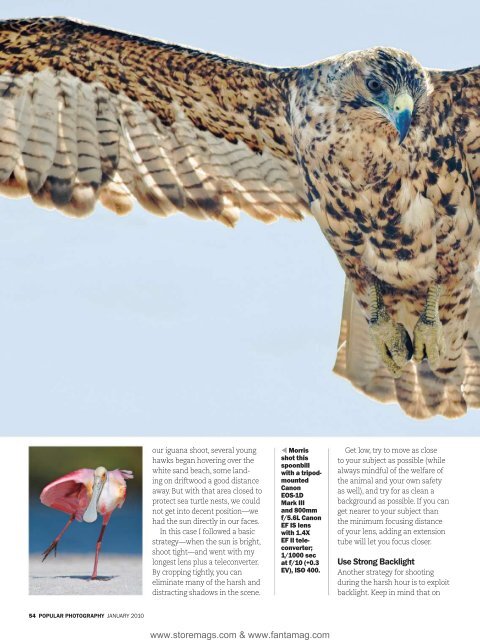photo - Ken Gilbert
photo - Ken Gilbert
photo - Ken Gilbert
Create successful ePaper yourself
Turn your PDF publications into a flip-book with our unique Google optimized e-Paper software.
54 popular <strong>photo</strong>graphy january 2010<br />
our iguana shoot, several young<br />
hawks began hovering over the<br />
white sand beach, some landing<br />
on driftwood a good distance<br />
away. But with that area closed to<br />
protect sea turtle nests, we could<br />
not get into decent position—we<br />
had the sun directly in our faces.<br />
In this case I followed a basic<br />
strategy—when the sun is bright,<br />
shoot tight—and went with my<br />
longest lens plus a teleconverter.<br />
By cropping tightly, you can<br />
eliminate many of the harsh and<br />
distracting shadows in the scene.<br />
Morris<br />
shot this<br />
spoonbill<br />
with a tripodmounted<br />
Canon<br />
EOS-1D<br />
Mark III<br />
and 800mm<br />
f/5.6L Canon<br />
EF IS lens<br />
with 1.4X<br />
EF II teleconverter;<br />
1/1000 sec<br />
at f/10 (+0.3<br />
EV), ISO 400.<br />
www.storemags.com & www.fantamag.com<br />
Get low, try to move as close<br />
to your subject as possible (while<br />
always mindful of the welfare of<br />
the animal and your own safety<br />
as well), and try for as clean a<br />
background as possible. If you can<br />
get nearer to your subject than<br />
the minimum focusing distance<br />
of your lens, adding an extension<br />
tube will let you focus closer.<br />
use Strong Backlight<br />
Another strategy for shooting<br />
during the harsh hour is to exploit<br />
backlight. Keep in mind that on

















